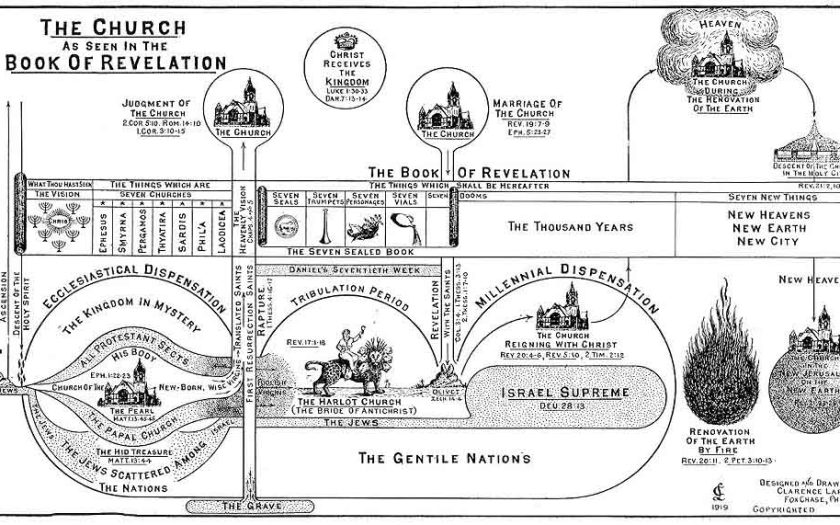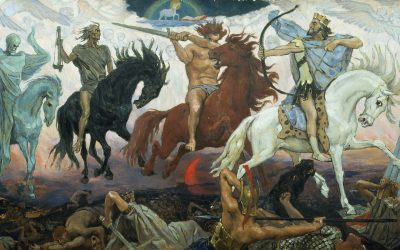If you cannot stand to read something that is really different from what you have believed for thirty years or more, then you should not read this. Then you had better keep reading the Bible as always, loving the Lord Jesus Christ, telling people of the Gospel and looking forward to the soon coming of the Lord Jesus. But I have to say something here. It is not about the essential things of our common Christian faith, so in that respect you need not worry. Nor is it about the rapture of the Church. But it is about how we interpret a very specific point related to the rapture.
The rapture of the Church is a mystery
That the congregation of the Lord Jesus is being raised by Him from this earth is a mystery (1 Corinthians 15:51). It had not been revealed by God in the Old Testament. Paul was the one who was allowed to reveal it. The doctrine of the rapture has been the subject of much debate and even a battle of pens among Christians.
But as far as I am concerned, the Bible is clear: the Lord Jesus is coming back to pick up His church and we will meet Him in the air. I also believe that this will happen without any announcement beforehand. Finally, I also believe that this will preserve us from the wrath of God that will come upon this world. On our own page are a few more links on this topic.
Yet, there is something about the rapture that I have never understood and has raised more and more questions with me in recent years. That has to do with the view that the presence of elders in Revelation 4 and 5 means that the church has been taken up into heaven. That way Revelation is read chronologically. First the time of the church on earth in chapters 2 and 3, then the vision in chapters 4 and 5 where the church is in heaven, and then the judgments in chapters 6 onward.

The schedules and consequences
This view also leads to all kinds of diagrams showing this sequence in time. Moreover, most diagrams then also draw the last week of Daniel. We then have a complete picture in which the Old and New Testament prophecies fit nicely. Moreover, in it we have the rapture nicely positioned.
With these explanations and diagrams, as time went on, I became more and more doubtful.
The first is how it is possible that the entire description of Revelation 6-19 could take place in a period of 7 years. I always have a lot of trouble imagining that. Now that in itself is not an argument, because if the Bible describes that this is so, then I gladly accept it. But the idea kept chafing. It was reinforced when I read Arnold Fruchtenbaum's book "The Footsteps of the Messiah" two years ago. That is certainly an informative and cleverly written book with a lot of valuable information, but it could not remove my doubts at this point. The author artfully weaves all kinds of prophecies from the OT into the scheme of Revelation and makes it into one. Which only adds to the complexity of the events in the week of the year.
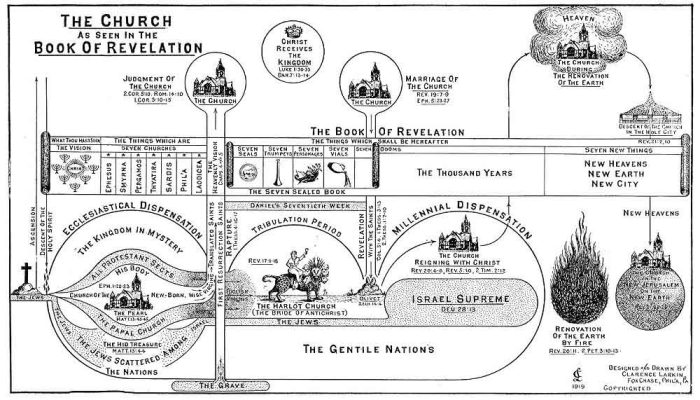
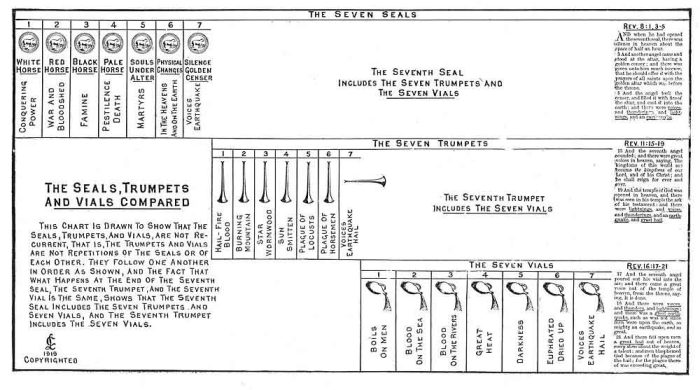
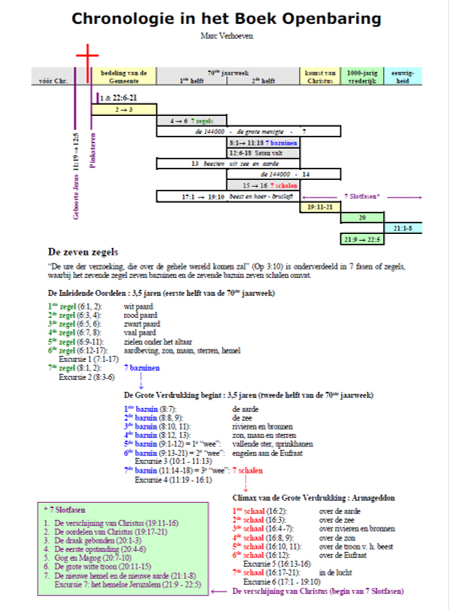
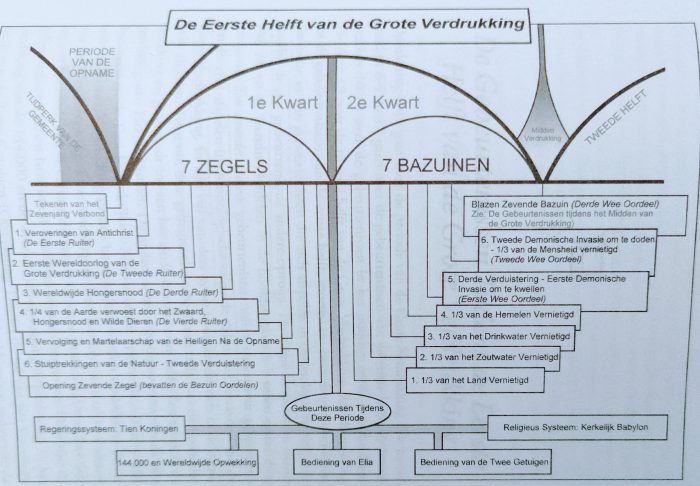
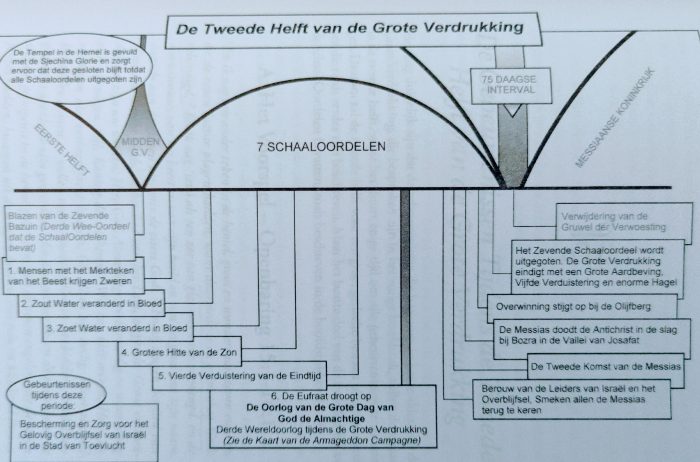
The second problem with reading Revelation chronologically was that I encountered things in it that were similar, but given the assumed chronology would apparently happen at a later time as well. The logic and coherence of that eluded me. But the explanation of Br. J. Buddingh that we already once before mentioned, did solve that problem in a sense. Simply put, he believes that the various judgments should be read in parallel. In that view, after the seven seals comes the judgment of Christ, the King of kings and Lord of lords (Revelation 19). Actually, he is saying that we should read Revelation as different narratives on the same major theme and over the same period of time. Just as we read the four Gospels, each Gospel having its own specific characteristics.
This way of reading is important, in my opinion, and we will return to it later.
On the rapture of the church
All the diagrams on Revelation tell us that the Church is taken up before the seals of the scroll are opened. For she is symbolically represented in Revelation 4:4 and onward in the 24 elders who are in heaven. So then the church is taken up into heaven, is the general explanation.
The diagrams are more or less complicated, but the basic pattern is always the same. Fruchtenbaum arrives at very complicated diagrams -see above- but he, too, believes that from chapter 4 the church is in heaven and the week of the year has begun.
Also H.L. Heijkoop held this view and that is how he expressed it, among other things, in the old booklet 'The Future'. On page 28 he says, 'Everything we find after Revelation 5, therefore, will happen after the church is in heaven'. But in the additional remarks at the end of the booklet (page 96) he apparently wrings his hands and at least leaves room for a different view. For he writes there that nowhere in the Bible it literally says that the church is taken up before the beginning of the last week of Daniel. That was actually also an encouragement to continue searching for an explanation that was more understandable to me.
There are many different views about the elders in heaven. I am not going to refute them all here, plenty has been written about them elsewhere (For example, Ouweneel "The Revelation of Jesus Christ" Part I). Personally, I think the 24 elders are a representation for the 12 tribes of Israel and of the 12 apostles of the church. The names of the 12 tribes of Israel and the names of the 12 apostles also appear on the gates and foundations of the New Jerusalem - the bride of the Lamb (Revelation 21:12,14).
Whether this is correct or not, each explanation is interpretation and in all cases it does not state directly that the church is in heaven.
- Perspective A (PA): the events of Revelation 6 take place after the rapture of the church.
- Perspective B (PB): the events of Revelation 6 could take place (in part) before the rapture of the church..
The question of whether the church is already in heaven or not is also of great importance for how we deal with the prophecy of this book. So when Revelation 6 and beyond happens after the rapture (PA), these are events that we will no longer experience here on earth. Then some things in these chapters can still be made sense of, especially if they have a strong relationship to Old Testament prophecies. But other things remain conjectural and difficult to interpret. For example, there are many different views about what the judgments at the seals would be. I mean no disrespect, but you then get a kind of Biblical divination.
Prophecy in the Bible is not there so that we can predict the future. Bible prophecy is primarily to show Who God is and how reliable His Word is; how reliable His promises are. That means looking back and seeing how the Lord has already foretold the things that are happening now. For example, Peter did this on the day of Pentecost when he explained the things that were happening then and had happened to the Lord Jesus with reference to Old Testament prophecies (Acts 2).
And what of the church history we see in Revelation 2 and 3? Only we who look back can say that these are prophecies that we have seen realized in history. But if you lived in the time of the apostles, it was impossible to interpret these letters prophetically. For them they only had an immediate meaning, which, by the way, they still have for us and which we may not pay enough attention to.
If the events with the seals have yet to occur - because the congregation has not yet been included (PA) - then the symbols are difficult to interpret. But would that other perspective (PB) also be possible: that we might be in the middle of it or a part has already passed unnoticed? And that we can also look back and see in that way what happened? Asking this question is completely impossible from the first perspective (PA), but logical and meaningful from the second perspective (PB).
Before we move on to explore perspective B, anyway, a word about the rapture from the letters to the believers in Thessalonica.
The rapture in Paul's letters to Thessalonica
A while ago I ran into 2 Thessalonians 2 and read something I had apparently always overlooked. There Paul addresses the question of the timing of the rapture (2:1). The believers in Thessalonica were persecuted and oppressed from the beginning (1 Thessalonians 1:6) and this continued (2 Thessalonians 1:4). In the process, they were deceived by people who believed that the judgment day of the Lord had already arrived (2 Thessalonians 2:2,3). But if that was so, what about the rapture of the church of which Paul had told them earlier (see 1 Thessalonians 4:16,17)? Would that then not be true, had they misunderstood, or - even worse - had they perhaps missed the rapture? In short, what about the rapture given the many persecutions?
Paul answers this question in the second letter to the Thessalonians, saying that the Lord's (judgment) day has not yet come because the following things must happen first: first the apostasy must come (2:3) and then the antichrist must show himself in the temple and say that he is God (2:4). Then he will suffer the judgment of the Lord (2:8); that is the (judgment) day of the Lord.
So Paul links the rapture of the believers to the revelation of the lawless one, which is when he appears as God in the temple of God. But first, therefore, the church must be taken up, because with that the dwelling place of the Holy Spirit on earth is also taken away. Then God's Spirit - who is called the restrainer - no longer dwells on the earth.
That revelation of the lawless one, the antichrist, is as we know at the halfway point of the 70and year-week. He then takes off his mask and shows who he really is.
When it would be correct that the rapture of the church would occur before the beginning of the 70and year week would be included, then Paul would have said so, wouldn't he? Then he could have been referring to the 7-year covenant that will be made with Israel or to the temple that would be rebuilt. But he doesn't; he mentions very explicitly and very specifically the middle of the year week and what will happen then in the temple in Jerusalem. I think that is of great significance.
Just letting go of the old idea: would it work?
Based on all these considerations
- I cannot conclude from the book of Revelation that the rapture of the church takes place before the seals of the scroll are opened.
- I believe I can see from the 2nd letter to Thessalonica that Paul positions the rapture of the church for the events at the midpoint of the 70th year-week.
You may well find the foregoing unconvincing; perhaps wanting or possibly even objectionable. That is allowed and I have no problem with that. But then I would still kindly ask you to continue with the search for a while.

Because suppose it is true and then unexpected vistas emerge?
Now suppose that we are now living in the time when one or more of the seals have already been broken, isn't that very special? What would that not tell us?
Then again, if you are still not convinced after the following articles, well, you just go back to the view that first the rapture must come before the seals are broken.
Still, I hope you will join me in the search and put aside your reservations for a moment.
In the next article, we will try to discover what the meaning may be of the scroll being opened. Then we will see if the events that take place at the seals can also already be placed in a historical perspective.
